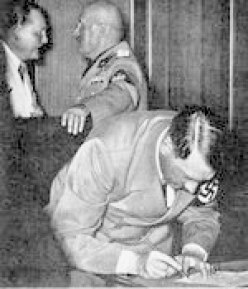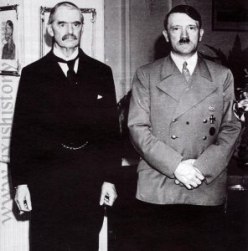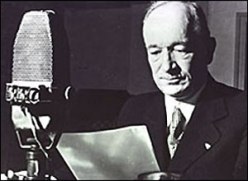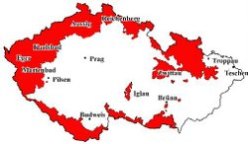 The Sudetenland
The Sudetenland
The mountainous borders of the Czech state were largely populated by a sizeable German-speaking minority. Although these Medieval German migrants had never been part of Germany proper, they fondly recalled the recently deceased German-speaking Austro-Hungarian Empire. However, on Hitler’s orders, the local Nazi leader Konrad Henlein stirred up the Sudentens against the multi-ethnic Czech state, thus creating a major crisis which, by the summer of 1938, was threatening to engulf Europe in a Second World War
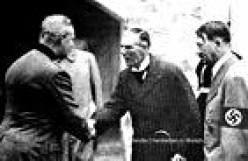 The Munich Sellout
The Munich Sellout
At a Conference held in Munich in September 1938, Britain, France, Germany and Italy met to discuss what to do about the crisis in Czechoslovakia. The Czechs weren’t even invited. The Munich Conference was in fact a series of meetings between the key players starting when Chamberlain flew to meet Hitler at Berchtesgarten on September 15 and concluding in Munich on 28th September when a document was approved and released to the world.
Terms of the Munich Agreement
Agreement reached on September 29, 1938, between Germany, the United Kingdom, France, and Italy:
“Germany, the United Kingdom, France, and Italy, taking into consideration the agreement, which has been already reached in principle for the cession to Germany of the Sudeten German territory, have agreed on the following terms and conditions governing the said cession and the measures consequent thereon, and by this agreement they each hold themselves responsible for the steps necessary to secure it’s fulfillment.
- The evacuation will begin on October 1st.
- The United Kingdom, France, and Italy agree that the evacuation of the territory shall be completed by October 10th, without any existing installations having been destroyed, and that the Czechoslovak Government will be held responsible for carrying out the evacuation without damage to the said installations.
- The conditions governing the evacuation will be laid down in detail by an international commission composed of representatives of Germany, the United Kingdom, France, Italy, and Czechoslovakia.
- The occupation by stages of the predominantly German territory by German troops will begin on October 1st. The four territories marked on the attached map will be occupied by German troops in the following order: the territory marked number I on the 1st and 2d of October, the territory marked number II on the 2d and 3d of October, the territory marked number III on the 3d, 4th, and 5th of October, the territory marked number IV on the 6th and 7th of October. The remaining territory of preponderantly German character will be ascertained by the aforesaid international commission forthwith and be occupied by German troops by the 10th of October.
- The international commission referred to in paragraph 3 will determine the territories in which a plebiscite is to be held. These territories will be occupied by international bodies until the plebiscite has been completed. The same commission will fix the conditions in which the plebiscite is to be held, taking as a basis the conditions of the Saar [territory ceded to France by the treaty of Versailles for 15 years; returned to Germany in 1935] plebiscite. The commission will also fix a date, not later than the end of November, on which the plebiscite will be held.
- The final determination of the frontiers will be carried out by the international commission. This commission will also be entitled to recommend to the four Powers, Germany, the United Kingdom, France, and Italy, in certain exceptional cases, minor modifications in the strictly ethnographical determination of the zones which are to be transferred without plebiscite.
- There will be a right of option into and out of the transferred territories, the option to be exercised within 6 months from the date of this agreement. A German-Czechoslovak commission shall determine the details of the option, consider ways of facilitating the transfer of population and settle questions of principle arising out of the said transfer.
- The Czechoslovak Government will, within a period of 4 weeks from the date of this agreement, release from their military and police forces any Sudeten Germans who may wish to be released, and the Czechoslovak Government will within the same period release Sudeten German prisoners who are serving terms of imprisonment for political offenses.
Adolf Hitler
Ed. Daladier
Mussolini
Neville Chamberlain
Munich, September 29, 1938
Annex to the Agreement
His Majesty’s Government in the United Kingdom and the French Government have entered into the above agreement on the basis that they stand by the offer, contained in paragraph 6 of the Anglo-French proposals of September 19th, relating to an international guarantee of the new boundaries of the Czechoslovak State against unprovoked aggression. When the question of the Polish and Hungarian minorities in Czechoslovakia has been settled, Germany and Italy for their part will give a guarantee to Czechoslovakia.
Munich, September 29, 1938
Additional Declaration
The four Heads of Government here present agree that the international commission, provided for in the agreement signed by them today, shall consist of the State Secretary in the German Foreign Office, the British, French, and Italian Ambassadors accredited in Berlin, and a representative to be nominated by the Government of Czechoslovakia.
Munich, September 29, 1938
Additional Declaration
The Heads of the Governments of the four Powers declare that the problems of the Polish and Hungarian minorities in Czechoslovakia, if not settled within 3 months by agreement between the respective Governments, shall form the subject of another meeting of the Heads of the Governments of the four Powers here present.
Munich, September 29, 1938
Supplementary Declaration
All questions which may arise out of the transfer of the territory shall be considered as coming within the terms of reference to the international commission.
Munich, September 29, 1938″
End of the First Republic
As a result of the Munich Agreement, the greatly weakened Czechoslovak Republic was forced to grant major concessions to the other non-Czechs within their borders.
In November 1938, Emil Hacha, succeeding Benes, was elected president of the federated Second Republic, consisting of three parts: Bohemia, Moravia, Slovakia, and Carpatho-Ukraine. Lacking it’s natural frontier and having lost its costly system of border fortification, the new state was militarily indefensible
The executive committee of the Slovak Populist Party met at Zilina on October 5, 1938, and with the acquiescence of all Slovak parties except the Social Democrats formed an autonomous Slovak Government under the quasi-fascist Father Tiso.
Similarly, the two major factions in Sub-carpathian Ruthenia, the Russophiles and Ukrainophiles, agreed on the establishment of an autonomous government, which was constituted on October 8, 1938. The pro-Ukrainian faction, led by Volosin, gained control of the local government, and Sub-Carpathian Ruthenia was renamed Carpatho-Ukraine.

